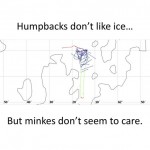Our primary scientific objective is to study interactions between humpback whales and their prey, krill.
This is why we tag the whales and why we are interested in the physical and biological factors that influence the distribution of the krill (see, Joe, we really are interested in the plankton. No, really, we are. Honest).
But we are also interested in understanding how humpbacks fit in to the broader ecological landscape of the Western Antarctic Peninsula, where there are many other krill predators. How do all these predators co-exist when they feed on the same prey? This is, of course, one of the central questions of ecology and one that is particularly amenable to study here in the relatively simple Antarctic ecosystem.

Our trusty survey platform the RVIB Palmer. We survey from the ice tower (the highest enclosed part of the ship).
One of the most important aspects of the seascape here is ice, which comes in many flavors, sizes and consistencies (which we have been learning). We have been particularly intrigued by the variation in ice cover in our study area. So today, in addition to recovering two tags and a crittercam, we conducted a visual survey to determine how ice cover affects the distribution of krill predators, including whales, seals, penguins and seabirds.
- Antarctic fur seal
We surveyed from the open water at the mouth of Wilhelmina Bay to the head of the bay, which is completely covered by ice. Sometimes we need complicated statistics to tease apart spatial patterns in animal distribution (that’s one of the many reasons Pat is with us), but sometimes the patterns are so obvious, even simple-minded scientists like me can see them.
- Crabeater seal – the red around the mouth is pigment from krill
The humpbacks are creatures of open water and do not penetrate the ice much at all. Antarctic fur seals are common at the ice edge (and by common I mean they are everywhere along this edge). As we moved further into the ice, we encountered crabeater seals (it’s a little marine mammal joke that crabeater seals eat krill and not crabs). And even further into the ice, in a tiny lead of open water, a couple of minke whales. We saw similar patterns with the birds. So, the ice is helping to structure the distribution of these predators in time and space. Very cool.

In this plot, the green line is our survey route (the red lines are off-effort transits) and the blue vectors are humpback sightings. There are two minke whale sightings (green vectors) at the head of the bay.
And, as a final aside, it is getting really cold here. I know that sounds dumb – we are in the Antarctic, after all – but the temperature is dropping and the ice in the bays is getting thicker and more extensive. Our trusty research vessel, the RVIB Nathaniel Palmer, is capable of breaking three feet of ice at three knots, and today we cut through some ice thick enough to stand on (note to concerned moms everywhere, no we did not try this).
- Our trail through the ice
Tomorrow – more tags, more surveys, more surprises.
Andy




Cold
This must be tough for you all. I could not handle this. These freezing tempertures would make me stress. I could not do this. But it would be awesome to go on a trip like this.